Frydenberg has spent big - but spend and save is the next big challenge: Firstlinks newsletter
The return of selling fees; Cycle investing; Helping the supply chain; Getting used to inflation; Population decline; Budget summary; 6% mortgages?
Every Federal Budget is a balance of politics and economics. On Tuesday, Treasurer Josh Frydenberg handed out some short-term goodies in the form of a reduction in fuel excise, a temporary tax cut of $420 for 10 million workers and a payment of $250 to 6 million welfare recipients. The sting in the tail is that the excise is scheduled to return in six months and the entire $1,500 Low and Middle Income Tax Offset (LMITO) will end next financial year, and any new government is facing these two potential grenades.
Both problems are the other side of the election, so it can be sorted out later. There was little in the Budget on superannuation, which seems to have lost its proclivity as a fiscal punching bag. Apparently, deficits don't matter as much as they used to and the retiree vote is too powerful. Here's the Budget Paper comment on the main item relating to super.
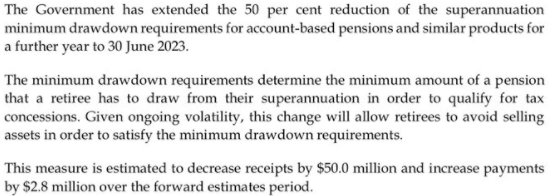
The SMSF and super industry loved it because it gives flexibility and retains funds in accounts. SMSF Association CEO John Maroney said:
“The temporary reduction in the minimum drawdown rates will help retirees manage the impact of volatility in financial markets. The reduction is designed to reduce instances where retirees may have to sell some superannuation investments in a volatile or depressed investment market simply to satisfy the Government’s minimum pension drawdown requirements, so, in the current geopolitical and Covid climates, extending the cut in drawdown rates is an important initiative that will help many retirees.”
Even the Treasurer now loves retirees, somewhat ironic given it was Scott Morrison as Treasurer who introduced the caps on the amount allowed in super pensions. Said Frydenberg:
“We recognise the valuable contribution self-funded retirees make to the Australian economy and the sacrifices they made to provide for their retirement. This will provide retirees with greater flexibility and certainty over their savings.”
Let's remember these words if Frydenberg becomes Prime Minister and looks again to target overly-generous retirement benefits.
In reality, the 50% drawdown reduction is no less an election ploy than the other handouts. It allows people to retain more money in tax-advantaged super when policy directs it should be drawn out. Markets have recovered strongly from the pandemic and most retirees are far wealthier than when this measure was introduced for a year in 2020, especially with the skyrocketing value of their homes. Anyone managing a superannuation pension who does not have the minimum legislated amount available in cash is not planning retirement properly. Nobody should need to 'sell in depressed markets' - and markets are not depressed anyway. It's another election sop with the Treasurer knowing around 1.8 million accounts are subject to the minimum drawdowns.
Looking longer term beyond the next election, the government's dilemma is to move to some semblance of fiscal responsibility while meeting expanding costs of health, education, NDIS and other welfare. A potential saviour is higher commodity prices, which are delivering a massive bonus and making Treasury's predictions of only a few months ago look conservative. Treasury also overestimated the damage caused by the pandemic on health and the economy, with low unemployment and a reduction in welfare costs kicking in.
Here's a snapshot of where all the money goes (the second item, 'Other purposes', is mainly payments to states and territories):
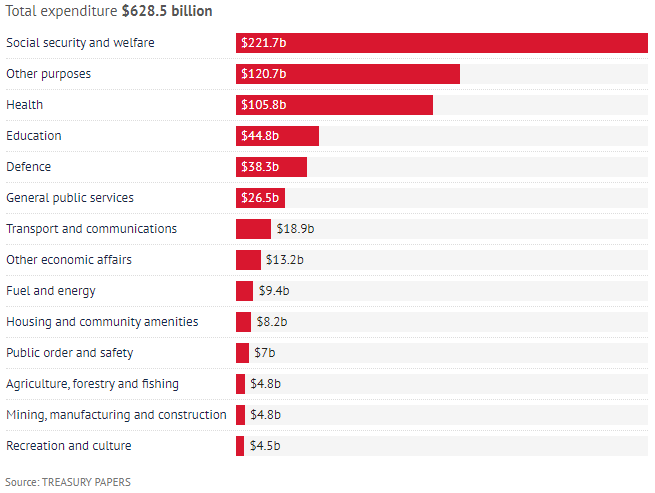
Financing a trillion dollars of debt becomes more expensive with higher interest rates, especially as the Reserve Bank scrapped its $350 billion bond buying program in February. This means real investors need to be found at higher yields. Hard to believe we were worried about having no bonds on issue only a decade ago.
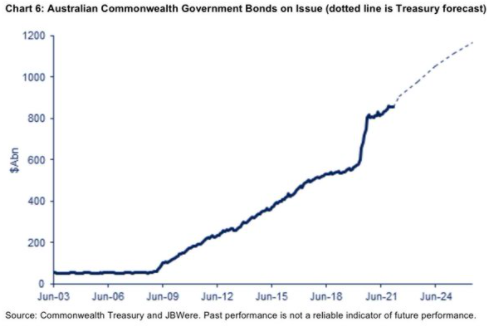
Bonds are seeing the type of volatility usually expected in equity markets, with the Bloomberg Aggregate Bond Index (US investment-grade bonds) falling in price over 6% this year, the worst quarter since 1980. Losses on global bonds are even higher.
This week, we look at inflation and interest rates with a few fresh perspectives and consider what the Reserve Bank will do over 2022 and 2023, knowing the central bank is itself guessing. Let's hope they guess right because if the futures markets are correct, as shown below, many borrowers will be handing over the keys and losing their dream. A bank bill rate of 3.5% would see variable mortgage rates near 6%. Surely not.
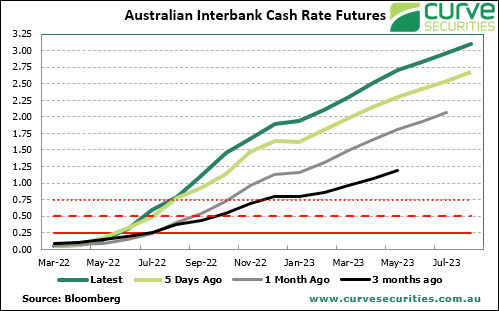
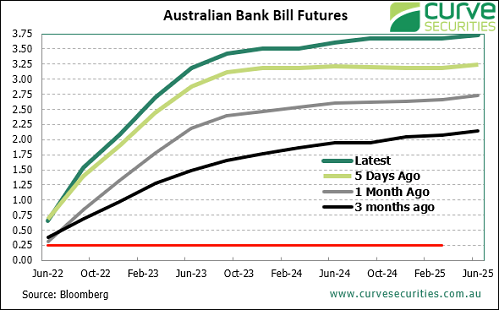
Graham Hand
***
Also in this week's edition ...
Remember how in 2020, Treasurer Josh Frydenberg banned conflicted remuneration called stamping fees, particularly targetting Listed Investment Companies and Listed Investment Trusts (LICs and LITs). Treasury had found many advisers and stockbrokers were not acting in the best interests of their clients. Now, with a rapid expansion of investors qualifying as 'wholesale', LICs and LITs are back and the issuers are lining up again.
Shane Oliver and Diana Mousina give their highlights of the 2022 Budget, noting that 'fiscal repair' in the medium term is in the form of restrained spending rather than austerity. Pre-election, the Budget aims to create far more winners than losers but with some stings in the tail.
The conventional logic is that bigger is better when it comes to population and innovation. More people means more researchers and innovators and more consumers to buy products services. However, Emma Davidson sees many benefits in the inevitable decline in global population.
Cameron McCormack explores how investors can navigate changing economic conditions by incorporating factors into their investing approach. He explores how quality, momentum, growth and enhanced value perform throughout the economic cycle.
The Covid-19 pandemic, and the range of policies aimed at mitigating its impact, has triggered a return to levels of inflation unseen for 40 years. Ashok Bhatia believes that there is a strong case for thinking about inflation in the asset allocation process, but also how it fits into the broader objective of portfolio diversification and income generation.
And finally, supply chain pressures highlight the important role and economic value created by companies working to make our infrastructure more efficient. Francyne Mu reviews two logistics companies that are well positioned to perform.

